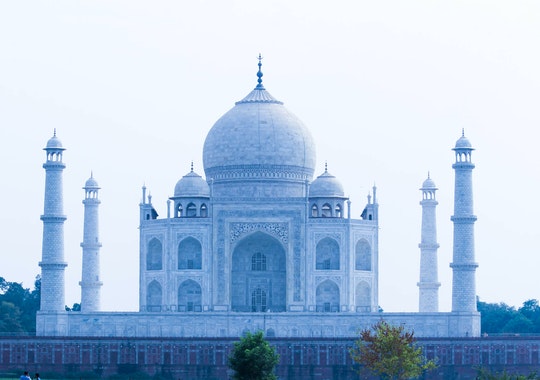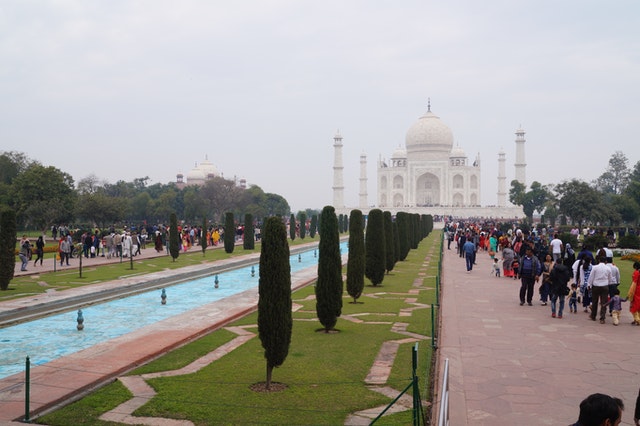ताजमहल आगरा
विश्व का सातवां अजुबा यानी ताजमहल उत्तर प्रदेश के ऐतिहासिक और प्रसिद्ध शहर आग्रा में यमुना नदी के दक्षिण तट पर स्थित है। वास्तव में यह एक मकबरा है जिसे विदेशी मुस्लिम आक्रांता बाबर के वंशज और दील्ली सल्तनत के तत्तकालीन बादशाह शाहजहां ने बनवाया था। इसे 1632 में मुगल बादशाह शाहजहाँ (1628 से 1658 तक) ने अपनी पसंदीदा पत्नी, मुमताज़ महल के मृत्यु के बाद उसके स्मरण में बनवाया था। बादशाह शाहजहां के चौदहवीं बच्ची गौहर बेगम को जन्म देते हुए मुमताज महल की मृत्यु हुई थी। इसमें स्वयं शाहजहाँ का मकबरा भी है। मकबरा 17-हेक्टेयर (42-एकड़) परिसर का केंद्रबिंदु है, जिसमें एक मस्जिद और एक गेस्ट हाउस शामिल है।
ताजमहल का इतिहास
 |
| Taj Mahal Agra (ताज महल) |
मकबरे का निर्माण अनिवार्य रूप से 1643 में पूरा हुआ था, लेकिन परियोजना के अन्य चरणों में अगले 10 वर्षों तक काम जारी रहा। माना जाता है कि ताजमहल परिसर 1653 में लगभग 32 मिलियन रुपये की लागत से पूरी तरह से बनकर तैयार हुआ था।
ताजमहल को उसके अद्भूत सौंदर्य के कारण 1983 में यूनेस्को विश्व धरोहर स्थल के रूप में घोषित किया गया था। यह कई लोगों द्वारा मुगल वास्तुकला का सबसे अच्छा उदाहरण और भारत के समृद्ध इतिहास का प्रतीक माना जाता है। ताजमहल प्रति वर्ष 7 से 8 मिलियन दर्शकों को आकर्षित करता है और 2007 में, इसे विश्व का सातवां अजुबा घोषित किया गया।
स्थापत्य कला
ताजमहल फारसी और मुगल वास्तुकला से निर्मित किया गया है।
कब्र ताजमहल के पूरे परिसर का मुख्य ध्यान केंद्रित भाग है। यह एक विशाल, सफ़ेद संगमरमर का एक चौकोर चबूतरा है, जो एक बड़े और गुंबद के आकार वाले एक इवान (एक मेहराब के आकार का द्वार) के साथ एक सममित इमारत से बना है।
 |
| Taj Mahal Agra (ताज महल) |
मुख्य संरचना एक बड़ा बहु-कक्षीय घन है जिसमें चार कोनों के साथ एक असमान आठ-तरफा संरचना होती है जो चार लंबे किनारों में से प्रत्येक पर लगभग 55 मीटर (180 फीट) है। इवान के प्रत्येक पक्ष को एक विशाल पिश्ताक या मेहराबदार मेहराब के साथ दो समान आकार की धनुषाकार बालकनियों के साथ बनाया गया है। चार मीनारें मकबरे को ढँकती हैं, एक चपरासी के कोनों का सामना करने वाले चबूतरे के प्रत्येक कोने पर। मुख्य कक्ष में मुमताज महल और शाहजहाँ की झूठी व्यंग्य रचना है; वास्तविक कब्रें निचले स्तर पर है।
ताजमहल परिसर के चारों ओर एक बड़े 300-मीटर (980 फीट) चौकोर चारबाग या मुगल गार्डन स्थित है। यह चारबाग उद्यान, फारसी बागों से प्रेरित एक डिजाइन, भारत में मुगल सम्राट बाबर द्वारा पेश किया गया था। मुगल काल के रहस्यवादी इस्लामी ग्रंथों में, स्वर्ग को मध्य वसंत या पर्वत से बहने वाली चार नदियों के साथ, उत्तर, पश्चिम, दक्षिण और पूर्व में बगीचे को अलग करने के लिए बहुतायत के एक आदर्श उद्यान के रूप में वर्णित किया गया है।
अन्य तथ्य
ताजमहल का निर्माण पूरे भारत और एशिया की सामग्रियों का उपयोग करके किया गया था। यह माना जाता है कि भवन निर्माण सामग्री के परिवहन के लिए 1,000 से अधिक हाथियों का उपयोग किया गया था। ताज महल को आकार देने के लिए 22,000 मजदूरों, चित्रकारों, कढ़ाई कलाकारों का उपयोग किया गया था। पारभासी सफेद संगमरमर मकराना, राजस्थान से लाया गया, पंजाब से जैस्पर, चीन से जेड और क्रिस्टल। फ़िरोज़ा तिब्बत से था और अफ़गानिस्तान से लापीस लाज़ुली, जबकि नीलम श्रीलंका से आया था और अरब से कारेलियन। सभी में, अट्ठाईस प्रकार के कीमती और अर्ध-कीमती पत्थरों को सफेद संगमरमर में जड़ा हुआ था।
 |
| Taj Mahal Agra (ताज महल) |
कैसे जाएं ताजमहल
स्थल: आग्रा, उत्तर प्रदेश, भारत
निकटतम हवाई अड्डा: आग्रा
निकटतम रेलवे स्टेशन: आगरा छावनी रेलवे स्टेशन
वर्तमान मुद्दें
सदियों से ताजमहल उपेक्षा और क्षय का विषय रहा है। 20 वीं शताब्दी की शुरुआत में लॉर्ड कर्जन के निर्देशन में भारत के ब्रिटिश वाइसराय के नेतृत्व में एक बड़ी बहाली की गई। हाल ही में, फाउंड्री और अन्य आस-पास के कारखानों से उत्सर्जन और मोटर वाहनों से निकलने वाले वायु प्रदूषण ने मकबरे को नुकसान पहुंचाया है, विशेष रूप से इसके संगमरमर के मुखौटे को। स्मारक के लिए खतरे को कम करने के लिए कई उपाय किए गए हैं, जैसे कि परिसर के चारों ओर पार्कलैंड बफर ज़ोन का निर्माण, और आस-पास के वाहनों पर प्रतिबंध लगाना। ताजमहल के लिए एक बहाली और अनुसंधान कार्यक्रम 1998 में शुरू किया गया था। स्मारक के चारों ओर पर्यावरण की स्थिति में सुधार की प्रगति हालांकि धीमी रही है।
--------------------------------------------
 |
| Taj Mahal Agra (ताज महल) |
--------------------------------------------
English Version
Taj Mahal Agra
The seventh wonder in the world, i.e. Taj Mahal, is located on the south bank of the Yamuna River in Agra, the historical and famous city of Uttar Pradesh. In fact, it is a mausoleum built by Shah Jahan, a descendant of the foreign Muslim invader Babur and the then emperor of the Delhi Sultanate. It was built in 1632 by the Mughal emperor Shah Jahan (1628 to 1658) in memory of his favourite wife, Mumtaz Mahal after her death. Mumtaz Mahal died while giving birth to Gauhar Begum, the fourteenth child of Emperor Shah Jahan. It also has the tomb of Shah Jahan himself. The mausoleum is the centerpiece of the 17-hectare (42-acre) complex, which includes a mosque and a guest house.
 |
| Taj Mahal Agra (ताज महल) |
Taj Mahal is one of the famous tourist places to visit in India.
History of Taj Mahal
Construction of the mausoleum was essentially completed in 1643, but work continued for the next 10 years in other phases of the project. The Taj Mahal complex is believed to have been fully completed in 1653 at a cost of around Rs 32 million.
The Taj Mahal was declared as a UNESCO World Heritage Site in 1983 due to its stunning beauty. It is considered by many to be the best example of Mughal architecture and a symbol of India's rich history. The Taj Mahal attracts 7 to 8 million visitors per year and in 2007, it was declared the seventh wonder of the world.
Architecture
The Taj Mahal is built from Persian and Mughal architecture.
The tomb is the main focus part of the entire complex of the Taj Mahal. It is a huge, white marble square platform, made of a symmetrical building with a large and dome-shaped one Ivan (an arch-shaped gate).
 |
| Taj Mahal Agra (ताज महल) |
The main structure is a large multi-orbital cube with an uneven eight-sided structure with four corners approximately 55 meters (180 ft) at each of the four long edges. Each side of the ivan is made with two similarly shaped arched balconies with a huge pishtaq or vaulted arch. Four towers cover the mausoleum, one on each corner of the plinth facing the corners of a peon. The main chamber contains Mumtaz Mahal and the false satire of Shah Jahan; The actual graves are on the lower level.
A large 300-meter square Charbagh or Mughal Garden is located around the Taj Mahal complex. This Charbag garden, a design inspired by Persian gardens, was introduced in India by the Mughal emperor Babur. In the Mystic Islamic texts of the Mughal period, heaven is described as an ideal garden of abundance, with four rivers flowing through the mid-spring or mountain, separating the garden in the north, west, south and east.
Other facts
The Taj Mahal was constructed using materials from all over India and Asia. It is believed that more than 1,000 elephants were used to transport building materials. 22,000 labourers, painters, embroidery artists were used to shape the Taj Mahal. Translucent white marble brought from Makrana, Rajasthan, jasper from Punjab, jade and crystal from China. Turquoise was from Tibet and Lapis Lazuli from Afghanistan, while Sapphire came from Sri Lanka and Karelian from Arabia. In all, twenty-eight types of precious and semi-precious stones were inlaid in white marble.
 |
| Taj Mahal Agra (ताज महल) |
How to reach Taj Mahal
VENUE: Agra, Uttar Pradesh, India
Nearest airport: Agra
Nearest railway station: Agra Cantonment railway station
Current issues
The Taj Mahal has been the subject of neglect and decay for centuries. In the early 20th century a major restoration was made under the leadership of the British Viceroy of India under the direction of Lord Curzon. Recently, emissions from foundries and other nearby factories and air pollution emitted from motor vehicles have damaged the mausoleum, most notably its marble facade. Several measures have been taken to reduce the threat to the monument, such as the construction of the parkland buffer zone around the complex, and the banning of nearby vehicles. A restoration and research program for the Taj Mahal was started in 1998. Progress on improving the environmental conditions around the monument, however, has been slow.
 |
| Taj Mahal Agra (ताज महल) |





No comments:
Post a Comment